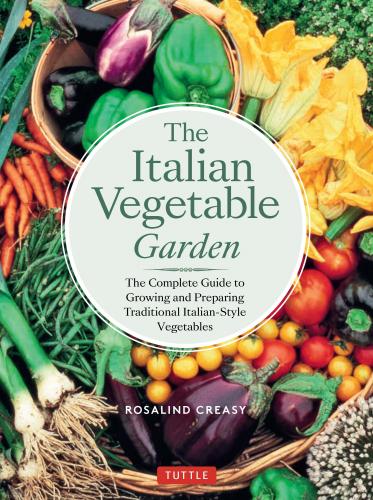The
Italian
Vegetable
Garden
The Complete Guide to Growing and Preparing
Traditional Italian-Style Vegetables
ROSALIND CREASY
Preface
How do I say this politely: my mother and our live-in grandmother were dreadful cooks. Especially when it came to vegetables. For one thing, most of our vegetables were frozen, or worse, canned, and they were always overcooked. Ugh, I still remember not being allowed to leave the table until I ate them. And garlic—I never tasted it until I went to college! When I questioned my English-born grandmother about garlic, she said very matter-of-factly, “We’re not Italian.” It was a perfect storm—we weren’t Italian, my mom and grandmother didn’t know how to cook, and it was Massachusetts in the 50s.
When I went off to college, I quickly learned that there was a whole world of food out there, and that I loved garlic! Of course most of it was on ubiquitous pizzas, and with pasta. That limited view changed in the early 70s when my husband and I traveled to Italy. It was clear that their cuisine was far more complex. In fact, an array of vegetables was integral to the meal, from the antipasto to the dessert; our first antipasto was cherry peppers stuffed with olives, another day it was a classic dish of “agliata,” a pungent garlic sauce served on grilled vegetables, and there were the grilled radicchios and young cardoon served with bagna cauda, (a hot garlic anchovy sauce), even a dessert tart made with chard. Contrary to what I—and most Americans—believed, Italians enjoy a long and broad cuisine based on vegetables. Over the last decades, as vegetarian and vegan movements have influenced all of us to include more vegetables in our own diets, we’ve come to learn that the Italian diet is in fact one of the healthiest in the world.
Years ago Italian immigrants had to grow their own rich-flavored serpent garlic, “rocambole,” Tuscan black kale, arugula, radicchio, and countless more vegetables because they couldn’t find them in the grocery stores. In fact, they couldn’t even find the seeds to grow them, so they would bring their own or have folks send them. Thankfully, times have changed, and we are in the golden age of vegetables and herbs, many of them of Italian origin. But while most markets now offer an array of Italian greens, canned San Marzano tomatoes, and the ubiquitous basil, I’ve yet to see many of the classics, including cardoons, purple artichokes, pereroncini peppers, tender sprouting broccolis, rustic arugula, yellow Romano beans, Italian red garlics, much less nepetella and young dandelions. The bottom line—to really explore and enjoy authentic Italian cuisine, you need to grow many of these vegetables yourself.
The great news is that over the last few decades dozens of dedicated seeds people, frustrated with the mainline vegetable seed companies and their meager Italian offerings, have started seed companies that specialize in Italian vegetables and herbs. Further, the now-popular heirloom movement has opened up vast seed libraries and seed swaps of classic Italian specialties. Never before have we had this much opportunity to explore one of the world’s greatest cuisines! With this book in hand you too can glory in a spring patch of wild Italian greens and show off a bountiful patio container of slim tender Italian eggplants and nepitella for a classic grilled eggplant and nepitella butter. And of course your trellis of San Marzano tomatoes will produce enough for many a killer pasta sauce.
Bon Appetito!
author Rosalind Creasy
Contents
Interview: The Sebastiani Vegetable Garden
Cabbage
Tuscan black kale
Capers
Cardoon
Chard
Chicories
Dandelion
Eggplant
Fennel
Lettuce
Nepitella
Onions
Garlic
Rocambole
Oregano and sweet marjoram
Parsley
Shelling peas
Peppers
Spinach
Squash
Tomatoes
Antipasto, Soups, Salads, Side Dishes, Pasta
Basil in Parmesan
Nepitella Butter
Pickled Capers
Dried Tomatoes
Roasted Pimientos
Mozzarella Marinated with Garlic, Dried Tomatoes and Basil
Misticanza
Classic Minestrone Soup
Bruschetta with Tomatoes and Basil
Radicchio and Corn Salad with Figs
